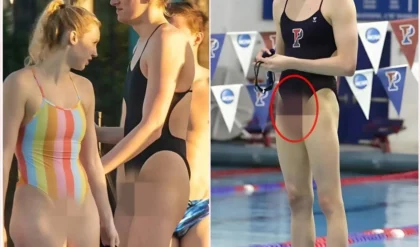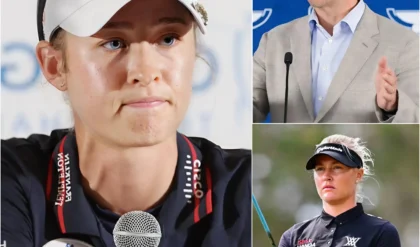Women’s basketball is having more than just a moment; it is undergoing a seismic revolution, and its epicenter has a name: Caitlin Clark. The game has never felt more alive, more relevant, or more electrifying. Arenas are sold out, television ratings are shattering decades-old records, and a legion of new fans, drawn by a magnetic force of talent and charisma, are tuning in. This tidal wave of popularity, dubbed the “Caitlin Clark effect,” feels like the dawn of a new era. Yet, lurking in the shadows of this golden age is a creeping, systemic rot—a coaching catastrophe that threatens to extinguish the very flame that Clark ignited. The story of her ascent is not just one of talent, but of trust. And in understanding the courage of her coach, Lisa Bluder, we uncover a disturbing truth: the next Caitlin Clark may already be on a bench somewhere, her genius being systematically dismantled.

To appreciate the crisis, one must first understand the blueprint. When Caitlin Clark arrived at the University of Iowa, she was a raw, untamed force of nature. She played with a breathtaking audacity, launching three-pointers from the logo, slinging no-look passes through impossibly tight windows, and playing with a swagger that straddled the line between confidence and recklessness. In many coaching programs across the country, this kind of player is seen as a problem to be solved. They are wild cards, unpredictable variables in a game where coaches crave control. The standard procedure is to sand down the rough edges, to drill the “bad habits” out of them, and to force them into a pre-defined system where they become a predictable, manageable cog in the machine.
But Lisa Bluder did the opposite. Where others saw risk, she saw revelation. She recognized that Clark’s “mistakes” were inextricably linked to her magic. The ill-advised deep three was the price of admission for the game-winner that would later make SportsCenter’s top ten. The risky pass was the necessary gamble for the assist that no one else could even see. Instead of breaking Clark and forcing her into a rigid system, Bluder did something far braver: she built the system around her. She gave her star player the rarest and most valuable gift a coach can offer—permission to fail. She cultivated an environment where creativity was not just tolerated but celebrated. Bluder’s philosophy was a masterclass in letting go, in trusting that a player’s innate genius, if nurtured, would ultimately yield far greater rewards than a team of perfectly disciplined, yet ultimately predictable, players
The result was a supernova. Freed from the fear of being pulled for a mistake, Clark flourished into a generational talent. She played with a joyous abandon that was infectious, and in doing so, she didn’t just win games; she captured the world’s imagination. She proved that women’s basketball could be a blockbuster spectacle, a prime-time event driven by personality and high-flying artistry. Lisa Bluder’s gamble paid off, providing a clear, undeniable blueprint for the future of the sport: find unique talent, trust it, and unleash it.
This makes the current reality of women’s basketball all the more tragic. Because for every Lisa Bluder, there are dozens of coaches who choose the opposite path. This is the darker side of the sport, the coaching catastrophe that is unfolding in gyms across the nation. It is a philosophy rooted in fear—fear of mistakes, fear of losing control, fear of the unknown. And its victims are the very players who possess the creative spark the game so desperately needs.

The poster child for this stifling conformity is, perhaps, University of South Carolina’s Malaysia Fullwiley. Watch her high school mixtape, and you will see a mirror of Clark’s fearless creativity. Fullwiley is an artist with the basketball, a dazzling ball-handler with a penchant for flashy, imaginative plays that leave defenders helpless and crowds roaring. She is precisely the kind of talent that should be at the forefront of this new era. Yet, during her team’s championship run, she was often relegated to the bench, sometimes playing as little as three minutes in a crucial game.
Her case is not an anomaly; it is a symptom of a widespread disease. In many top-tier programs, players like Fullwiley are treated as liabilities. Their instincts are labeled “undisciplined.” Their creativity is seen as a deviation from the system. They are coached to within an inch of their lives, told to stop taking risks, to make the safe pass, to fit the mold. The vibrant, unpredictable artist who arrived on campus is slowly chiseled down into a cautious, hesitant role player. The very qualities that made them special are identified as weaknesses to be eliminated.
This is not an indictment of any single coach, not even a powerhouse like South Carolina’s Dawn Staley, whose record of success is undeniable. Her system works; it produces championships and builds formidable, disciplined teams. However, the conflict arises when a uniquely creative talent enters a system that prioritizes structure above all else. Is there room in such a system for a player whose brilliance lies in her ability to break structure? The evidence suggests that, all too often, the answer is no. The player must conform to the system, and if they cannot, their potential is sacrificed at the altar of control
This rigid mentality is not just a disservice to the players; it is a catastrophic business decision for the sport itself. Fans are not flocking to arenas and tuning in by the millions to watch perfectly executed, methodical offensive sets. They are coming for the magic. They are coming for the jaw-dropping moments of brilliance, the logo threes, the impossible assists, the sheer joy of watching an artist at the peak of their powers. Caitlin Clark proved that creativity sells. Audacity sells. By forcing players into a straitjacket of conformity, the sport is actively turning away the very audience it has just begun to capture. It is a form of self-sabotage, driven by an outdated coaching orthodoxy that values mistake-free basketball over inspiring basketball.
As Clark transitions to the WNBA, this philosophical war for the soul of the game will only intensify. Will her new coaches embrace her unique style, as Bluder did, or will they attempt to rein her in, to make her “fit” a more traditional professional system? The answer will have profound implications not just for her career, but for the entire league. It will send a message to every young, creative player about what is truly valued at the highest level: originality or obedience?





